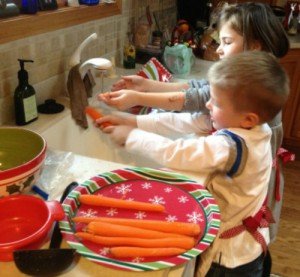
Parents everywhere breathe a collective sigh of relief when the first day of school comes around. But after the first week or so of quiet, we remember how much we can miss our kids during the school day and start looking for ways to spend quality time together and to participate in their education. The mental picture of having your kids in the kitchen could be anything from blissful, to fun, to chaotic, or even dangerous.
Learn why getting kids in the kitchen is beneficial and five tips for making it work for you.
(And p.s. – get ready for some seriously cute pics of our kiddos in the kitchen!)


Why Invite Your Kids into the Kitchen?
It sounds scary, but reminding ourselves why can give us the momentum we need to get started.
- Kids learn valuable life lessons in the kitchen: safety, responsibility, nutrition, how to follow instructions, and hospitality.
- Very practically, your kids will soon be capable enough to share the workload.
- Family meals bring togetherness instead of division. Allowing kids to make own their food choices helps minimize picky eater battles.
Now, how do you make it work without chaos descending in the kitchen?
1. Be Safe and Have Fun
While having fun is the goal, a cooking lesson that ends in a trip to the emergency room is no fun. Keep the mood light and relaxed, but make sure you lay some ground rules for safety.
Ground Rules for Safety Examples:
- Knife safety – Katie and Kitchen Stewardship has a great eCourse!
- Using caution around hot surfaces
- Good sanitary practices (especially with raw meats)
- Using caution around electrical appliances (mixers, food processors, etc.)
- Proper cleanup procedures (handwashing, work area, etc.)
Tailor your instructions to the age of your children. For very young children you may consider cooking with them at the table so that they are not able to reach sharp or hot objects. Once your kids have mastered the ground rules, they will move forward with confidence and everyone can enjoy the experience more fully.
2. Try for Ideal Conditions
We are parents too, and we understand things don’t always go as planned. However, here are a few suggestions to help plan for success:
- Allow ample time to finish the cooking project. Let kids help on the weekends. Let them help with prep for your freezer cooking day, but cook alone on the big day.
- Start with a clean kitchen. This helps keep everyone calm and focused. Of course, you’ll want to teach them to clean up too!
- Avoid too many cooks in the kitchen. Take turns having one-on-one time with a parent in the kitchen. Have younger children take turns stirring or adding ingredients.
- Be mindful of attention span limits. If a younger child is losing interest or an older child is becoming frustrated, it is ok to take a break or ask them to come help another time.
3. Assign Age-Appropriate Tasks
Children become frustrated when you give them a task that they aren’t capable of completing. It can also be frustrating as a parent to look on while a child “messes up” a recipe, flings food all over the place, or worse does something dangerous in the kitchen.
Unless you have the patience of Job (I don’t) or it really doesn’t matter if the recipe turns out or not (i.e. it isn’t your only dinner option that night), then you should do your best to give your child tasks that suit his age and development.
These lists are not exhaustive, and obviously each child matures at a different rate, so use your common sense and your own parental instincts as a guide.
Don’t underestimate how capable your children can be in the kitchen either!
Kids love to feel like valuable, contributing members of the family. Seeing them beam with pride over a job well done is so rewarding, so don’t miss out! Here are some examples of tasks suited to different age groups:
Toddlers & Preschoolers (2-4)
Sprinkle cheese or toppings, smash potatoes (or bananas or avocados) with a hand masher, dump pre-measured ingredients into a bowl, stir ingredients, decorate cookies (but be prepared for a mess!), shake a zippered bag to batter meat, knead or punch down dough, push buttons on the blender or food processor, or teach them to help with table setting and clearing.
School-Aged Children (5-10)
Teach them how to read a recipe, teach them to cut soft ingredients with a safe knife, measure ingredients into a bowl, toss a salad, crack eggs, roll out the dough and cut out cookies, set the temperature or timer for the oven, make sandwiches and snacks for themselves or pack their own lunch, simple stove tasks with supervision (i.e. boiling pasta, scrambling eggs, flipping pancakes, etc.), wash dishes or load the dishwasher.
Teens and Young Adults (11-18)
Teach how to chop and prep ingredients safely (i.e. knife safety, dealing with raw meat, etc.), teach oven safety, bake a batch of cookies, let them try a simple meal on their own (maybe a family favorite they have helped you make many times or a simple breakfast or lunch), package leftovers and clean up the kitchen after a meal, let them help with meal planning, and definitely get them involved in a cooking day, like our new Kids Helping Mini Meal Plan!
4. Use the Time as a Teachable Moment
Everyone has to eat! My goal for my kids is that they can at least prepare a few basic meals for themselves by the time they move out of the house. If they are interested, we can do more!
But cooking involves other important life skills, such as making nutritious food choices.
How to Help Kids Make Nutritious Choices
- Let kids try new veggies and fruits and teach them how to prepare them.
- Talk about eating sweets and treats in moderation.
- Teach them how to plan a balanced meal or a healthy weekly meal plan.
Here is an example from Regan, a former OAMM staffer when her daughter was in preschool.
“When I am planning out our meals for the week, I get out a few of the kid’s cookbooks we have and let Sophia go through and pick out some side dishes. Then I help her go through and we make her a grocery list and she is in charge of getting those things at the grocery store and helping me make them at dinner. We also have a chart with a bunch of different vegetables, where she gets to mark off every time she tries them, so sometimes we’ll look online for a recipe with one of those.”
Kids in the kitchen can learn a little about almost every subject at any age!
Kitchen Task & School Subjects:
- Math: Fractions, measuring, and measurement conversions are only the start. For young children, have them count, add, and subtract ingredients. For older kids, teach them to multiply or divide a recipe.
- History and Geography: Cook international recipes or traditional recipes from history.
- Culture and Religion: Explore recipes associated with different holidays.
- Science: All cooking is really chemistry, and you can study biology by cooking yeast breads and yogurt.
- Art: Focus on presentation or food photography. Teach colors and shapes to young children.
- Language: Practice reading and comprehending recipe instructions or learn cooking words that come from other languages. For very young children ask questions like, “What letter does apple start with?”
Homeschoolers can easily add these hands-on activities to their lessons, but any parent can get involved in their child’s education by inviting them into the kitchen. Sometimes a child who struggles in the classroom can really benefit from the one-on-one attention and the hands-on nature of cooking. They might not even notice they are practicing math!
You can also teach some important character-building lessons in the kitchen.
Character Building Lessons:
- Invite some friends over and practice being a good host or hostess.
- Discuss table manners.
- Prepare a meal for someone in need. (For more ideas, see the Freeze it Forward section of our blog.)
Check out the Kids Cook Real Food E-course!
This 8-week course taught by Katie of Kitchen Stewardship teaches kids of 3 different age levels how to cook confidently and competently! Over 8 weeks kids will learn over 30 basic skills through videos, written materials, and hands-on practice with kid-friendly recipes.
5. Enjoy the Fruits of Your Labor
Make sure you eat what you make together!
In my opinion, this is the best part. Consider your end goal before you start picking recipes. Sometimes you can get a child interested in the food they otherwise wouldn’t eat by asking for their help to cook it. Unfortunately, this isn’t a guarantee. If your main goal is to get your child interested in helping in the kitchen, then go ahead and let them pick a recipe or an ingredient that they love to eat, and you are sure to capture their interest.
Things to Remember:
- Do lots of deep breathing during the process
- Remind yourself that there is food at the end for comfort.
- Take lots of pictures with your kids (and kitchen) covered in flour. (You will cherish them – I promise!)
**This post may contain affiliate links.**
